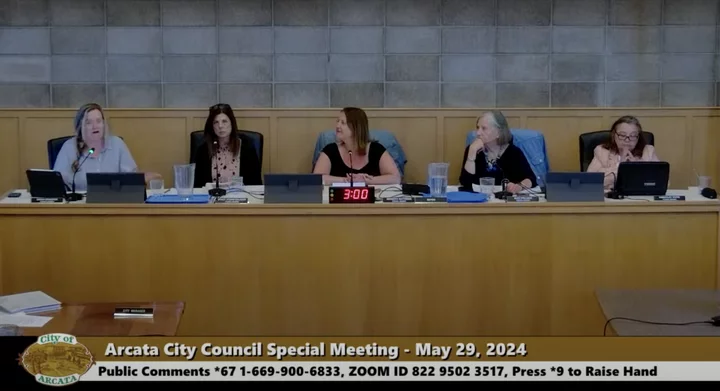Screenshot of Wednesday’s Arcata City Council Meeting.
At a public hearing for the Gateway Area Plan and General Plan last night, Arcata City Council members discussed final changes they’d like to see before ratifying the documents. The plans, which establish policies and zoning changes that will likely change Arcata’s housing landscape in the coming decades, will come before the Council twice more in the coming months.
Because Vice Mayor Alex Stillman and Councilmember Stacy Atkins-Salazar have recused themselves from Gateway Area-related topics due to conflicts of interest, discussion on the Gateway Area Plan and General Plan were split into two agenda items.
Here’s a quick rundown of what they talked about.
Gateway Area Plan and Code
Over the first half of the meeting, Mayor Meredith Matthews and Councilmembers Sarah Schaefer and Kimberley White discussed the Gateway Area Plan and Gateway Code, which will rezone 139 acres of southwest Arcata to pave the way for mixed-use and high-density housing development.
During the public comment period, quite a few folks advocated for a linear park along the L Street trail. Afterwards, the three non-recused Councilmembers discussed ways to protect and further develop the existing bike and walking path on L street, from Samoa Boulevard to Alliance Road. They decided to add language that guarantees protection of the L Street path in the plan, and to add a measure for the development of a linear park along the L Street path over the next two years.
To increase transparency, the Council also changed the review process for taller buildings. Instead of the Zoning Administrator, the Planning Commission will hear proposals for buildings four stories or higher, which will include a public administrative hearing.
General Plan 2045
The full Council convened to discuss the General Plan 2045 comprehensive update during the second half of the meeting. They requested a few minor changes to the Plan, and also discussed some concerns related to sea level rise and the Arcata Fire District.
The General Plan’s policy on pedestrian pathways and multi-use trails calls to “retain and expand” total trail feet in Arcata, and says that if developers ever want to remove or relocate a trail, the final call is up to the City. After Community Development Director David Loya clarified it would be specifically the City Council’s discretion in those cases – not the zoning administrator’s, as some community members have feared – the Council opted to change the language of the policy to affirm the Council’s authority over trail relocation and removal.
“I feel like in our community, trails are a big deal to everyone,” said Councilmember Atkins-Salazar. “I think that it’s important that there is a process – if we need to, for whatever reason, consider moving a trail, then it should be a process – and it’s my understanding that it would be a process.”
The Council also agreed to change a detail in the Land Use Policy. An implementation measure titled “Residential-Low Density Rezone” directs the City to, in a couple of years, consider allowing more mixed-use and housing development in certain neighborhoods, including Bayview, Northtown, Arcata Heights, and Sunset. Councilmember White worried that new development permitted by the potential rezone wouldn’t “fit” with the neighborhoods, and suggested removing the measure.
Loya clarified that the policy wouldn’t rezone those neighborhoods – it would just commit the City Council to surfacing the idea a couple years into the implementation of the General Plan.
“I 100 percent support this policy,” said Councilmember Schaefer, noting that the affected neighborhoods have desirable access to schools, parks and services, and that limiting more affordable housing options there would be exclusionary. Referring to mixed-use neighborhoods, Schaefer said: “That is true community, and that is what good neighborhoods look like.”
The Council chose to delay consideration for the rezone policy from year two to year four of the General Plan’s implementation, in part to see how development of the Gateway Area pans out.
Other topics didn’t result in changes to the Plan. Councilmember White worried how the Plan will affect areas that will, sooner or later, face sea level rise. Loya clarified that the Local Coastal Plan, projected for completion around early 2025, will overlay the General Plan and account for those concerns.
“The current version of the local coastal program actually does not allow for densification in areas that are subject to sea level rise,” Loya said. While that version does allow land use changes, “those zoning changes are really geared towards early incentives to put us on the path towards longer term adaptation and retreat from that area.”
Other than that, the Council talked a bit about the Arcata Fire District (AFD), which has raised concerns about its ability to respond to disasters in large buildings. AFD has asked the Council to delay approving the Gateway Area Plan pending a Standard of Coverage Study, which will evaluate future needs of AFD and should be complete by the end of the year. Councilmember White read a letter outlining AFD’s concerns, which AFD Board President Eric Loudenslager sent to the Council earlier this week.
Some members seemed confused by the AFD’s most recent letter given the City’s efforts to collaborate. Because the issue is tied to funding, it’s largely beyond the City’s control. Noting that the plan can be amended after its ratification, and that the fire marshall will have to sign off on all new buildings anyway, the Council moved on without requesting changes.
Given the late hour, the Council decided to continue discussion on the plans at their June 5th and July 17th meetings. You can check out the Gateway Area Plan here and the General Plan here, where recent changes are marked in red.

CLICK TO MANAGE